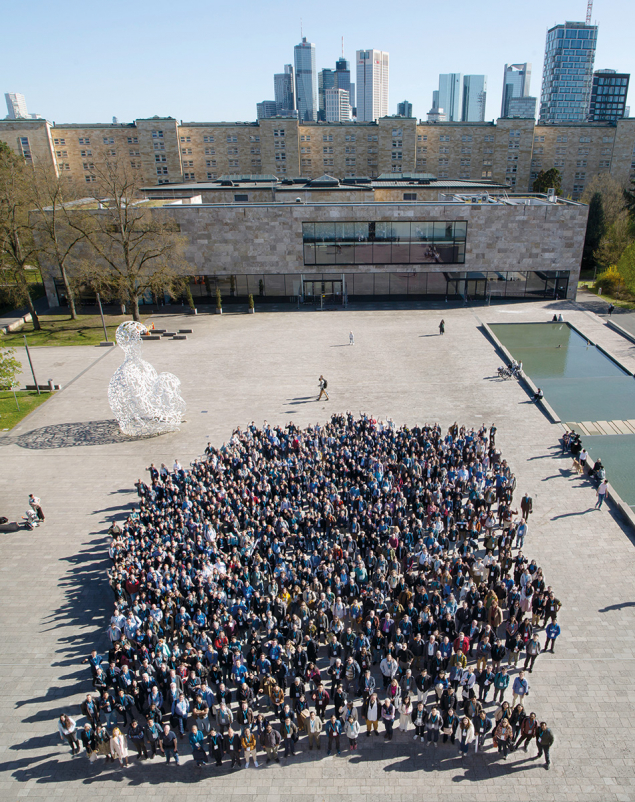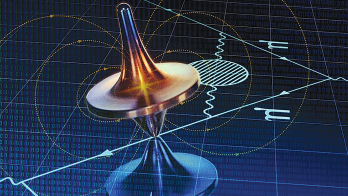
The 31st Quark Matter conference took place from 6 to 12 April at Goethe University in Frankfurt, Germany. This edition of the world’s flagship conference for ultra-relativistic heavy-ion physics was the best attended in the series’ history, with more than 1000 participants.
A host of experimental measurements and theoretical calculations targeted fundamental questions in many-body QCD. These included the search for a critical point along the QCD phase diagram, the extraction of the properties of the deconfined quark–gluon plasma (QGP) medium created in heavy-ion collisions, and the search for signatures of the formation of this deconfined medium in smaller collision systems.
Probing thermalisation
New results highlighted the ability of the strong force to thermalise the out-of-equilibrium QCD matter produced during the collisions. Thermalisation can be probed by taking advantage of spatial anisotropies in the initial collision geometry which, due to the rapid onset of strong interactions at early times, result in pressure gradients across the system. These pressure gradients in turn translate into a momentum-space anisotropy of produced particles in the bulk, which can be experimentally measured by taking a Fourier transform of the azimuthal distribution of final-state particles with respect to a reference event axis.
An area of active experimental and theoretical interest is to quantify the degree to which heavy quarks, such as charm and beauty, participate in this collective behaviour, which informs on the diffusion properties of the medium. The ALICE collaboration presented the first measurement of the second-order coefficient of the momentum anisotropy of charm baryons in Pb–Pb collisions, showing significant collective behaviour and suggesting that charm quarks undergo some degree of thermalisation. This collective behaviour appears to be stronger in charm baryons than charm mesons, following similar observations for light flavour.
A host of measurements and calculations targeted fundamental questions in many-body QCD
Due to the nature of thermalisation and the long hydrodynamic phase of the medium in Pb–Pb collisions, signatures of the microscopic dynamics giving rise to the thermalisation are often washed out in bulk observables. However, local excitations of the hydrodynamic medium, caused by the propagation of a high-energy jet through the QGP, can offer a window into such dynamics. Due to coupling to the coloured medium, the jet loses energy to the QGP, which in turn re-excites the thermalised medium. These excited states quickly decay and dissipate, and the local perturbation can partially thermalise. This results in a correlated response of the medium in the direction of the propagating jet, the distribution of which allows measurement of the thermalisation properties of the medium in a more controlled manner.
In this direction, the CMS collaboration presented the first measurement of an event-wise two-point energy–energy correlator, for events containing a Z boson, in both pp and Pb–Pb collisions. The two-point correlator represents the energy-weighted cross section of the angle between particle pairs in the event and can separate out QCD effects at different scales, as these populate different regions in angular phase space. In particular, the correlated response of the medium is expected to appear at large angles in the correlator in Pb–Pb collisions.
The use of a colourless Z boson, which does not interact in the QGP, allows CMS to compare events with similar initial virtuality scales in pp and Pb–Pb collisions, without incurring biases due to energy loss in the QCD probes. The collaboration showed modifications in the two-point correlator at large angles, from pp to Pb–Pb collisions, alluding to a possible signature of the correlated response of the medium to the traversing jets. Such measurements can help guide models into capturing the relevant physical processes underpinning the diffusion of colour information in the medium.
Looking to the future
The next addition of this conference series will take place in 2027 in Jeju, South Korea, and the new results presented there should notably contain the latest complement of results from the upgraded Run 3 detectors at the LHC and the newly commissioned sPHENIX detector at RHIC. New collision systems like O–O at the LHC will help shed light on many of the properties of the QGP, including its thermalisation, by varying the lifetime of the pre-equilibrium and hydrodynamic phases in the collision evolution.







